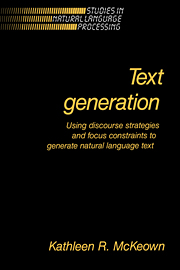Book contents
- Frontmatter
- Contents
- Preface
- 1 Introduction
- 2 Discourse Structure
- 3 Focusing in discourse
- 4 TEXT system implementation
- 5 Discourse history
- 6 Related generation research
- 7 Summary and conclusions
- Appendix A Sample output of the TEXT system
- Appendix B Introduction to Working
- Appendix C Resources used
- Appendix D Predicate Semantics
- Bibliography
- Index
- Frontmatter
- Contents
- Preface
- 1 Introduction
- 2 Discourse Structure
- 3 Focusing in discourse
- 4 TEXT system implementation
- 5 Discourse history
- 6 Related generation research
- 7 Summary and conclusions
- Appendix A Sample output of the TEXT system
- Appendix B Introduction to Working
- Appendix C Resources used
- Appendix D Predicate Semantics
- Bibliography
- Index
Summary
There are two major aspects of computer-based text generation: 1) determining the content and textual shape of what is to be said; and 2) transforming that message into natural language. Emphasis in this research has been on a computational solution to the questions of what to say and how to organize it effectively. A generation method was developed and implemented in a system called TEXT that uses principles of discourse structure, discourse coherency, and relevancy criterion. In this book, the theoretical basis of the generation method and the use of the theory within the computer system TEXT are described.
The main theoretical results have been on the effect of discourse structure and focus constraints on the generation process. A computational treatment of rhetorical devices has been developed which is used to guide the generation process. Previous work on focus of attention has been extended for the task of generation to provide constraints on what to say next. The use of these two interacting mechanisms constitutes a departure from earlier generation systems. The approach taken here is that the generation process should not simply trace the knowledge representation to produce text. Instead, communicative strategies people are familiar with are used to effectively convey information. This means that the same information may be described in different ways on different occasions.
The main features of the generation method developed for the TEXT strategic component include 1) selection of relevant information for the answer, 2) the pairing of rhetorical techniques for communication (such as analogy) with discourse purposes (for example, providing definitions) and 3) a focusing mechanism.
- Type
- Chapter
- Information
- Text Generation , pp. ix - xPublisher: Cambridge University PressPrint publication year: 1985

